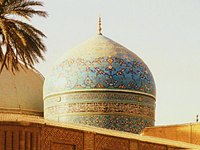Mawsim
[6] In the Berber areas of the Maghreb, almost every village had[clarification needed] its saint or marabout and a small domed tomb or mausoleum (qubba) of the same name.[10] The religious practices relating to the mawsim are based on the tilawa (ritual recitation) of the complete and integral sixty hizbs of the Quran, the Sufi salka.[12] Collective catering around large couscous dishes is a central quality of these festivities in order to socialize people attending the mawsim around traditional culinary foods in addition to the recitation of the Quran, Dhikr and Qasidas.[14] These religious, sociological and gastronomic aspects make it possible to weld the cultural and existential breaches of patriarchal societies and to preserve the intangible heritage of populations, especially rural ones.[15] Group salah (prayer), collective tarteel, team tasting of dishes and couscous, choral singing of Al-Burda, appreciation of the artistic performances of fantasia, humming of poems and qasidas, as well as other activities, make mawsim a proven factor of social cohesion and individual appeasement.
SufismAbdul Qadir GilaniAl-Insān al-KāmilDervishHaqiqaKaramatLataifManzilMa'rifaMurshidQalandarQayyumSilsilaSufi cosmologySufi metaphysicsSufi philosophySufi poetrySufi psychologyTazkiahYaqeenAnasheedHaḍraMuraqabahQawwaliWhirlingZiyaratSufi ordersAliansBa 'AlawiBektashiQadiriChishtiNaqshbandiShadhiliSuhrawardiRifa`iKhalwatiRahmaniBadawiDesuqiTijaniDarqawiIdrisiSenusiBayramiJelvetiMaizbhandariMalamatiMouridiSülaymaniyyaSalihiyyaAzeemiaKubrawiMevleviShattariUwaisiHurufiNi'matullāhīNuqtaviQalandariSafaviZahabiyaAkbariGalibiHaqqani AnjumanInayatiIssawiyyaJerrahiMadariMahdaviNoorbakshiZahediNotable earlyNotable modernSingersTawhidShariaTariqaHistorySufi musicPersecutionArabicMaghrebMaraboutsTariqasmuridsnovicesFantasiaAlgeriaPalestinianNabi MusasheikhMausoleumBerbertilawaal-BurdaMuhammadMawlidProphet's MosqueMedinacouscousQasidastarteelfantasiasNaâmaTiaretTlemcenBéni AbbèsBecharTan-Tan MoussemMoroccoNorthwest AfricaTan-TanSebibaTweezaWezeeaZawiyas in AlgeriaAhl al-KhutwaBash HezzabHezzabKhatibMajzoobMaraboutMuqaddamMuqarrabNass al-Houdhour




